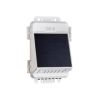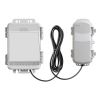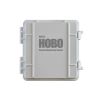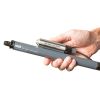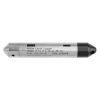HOBO MicroRX Water Level Station
Features
- Eliminate complicated manual calculations with pre-programmed water flow formulas
- Act quickly in response to alarms triggered at time of measurement for water flow and accumulated rainfall
- Reduce maintenance visits with the non-vented water level sensor
- Free ground shipping
- Expedited repair and warranty service
- Lifetime technical support
- More
Overview
The Onset HOBO MicroRX Water Level Station is a cellular, web-enabled water level monitoring solution for stormwater, floodwater, irrigation, hydrologic, and environmental applications. Pre-programmed water flow formulas for select weirs, flumes, and a stage discharge table result in an easy and intuitive configuration.
Mechanics
New water flow and accumulated rainfall calculations, which are performed directly on the station at time of measurement, trigger immediate notifications of critical water level conditions. The compact and durable station, together with the non-vented water level sensor, enables harsh condition deployments and reliable monitoring. The optional integrated solar panel or battery power, with a wide range of plug-and-play smart sensors, supports flexible environmental monitoring.
Benefits
- Station-side alarms for water flow and accumulated rainfall triggered at time of measurement
- Non-vented ceramic water level sensor with a choice of four ranges
- Interchangeable, Kevlar-reinforced water level sensor cables
- Integrated barometric pressure sensor
- Compact IP66/NEMA 4X enclosure
- Built-in LCD confirms proper setup and operation
- Two power options:
- Integrated 1.7 W solar panel with rechargeable battery pack
- 5 W and 15 W external solar panels can be added (RX2104 only)
- User-replaceable AA lithium batteries
- Inputs for five plug-and-play sensors
- Up to 10-minute connections rates via 4G cellular data plans
- Cloud-based monitoring and data access through HOBOlink
- Available with stainless steel or titanium sensor ends
- 3-point NIST-traceable calibration certificate included for the water pressure sensor
In The News
Three Decades of Research at Acton Lake
A multi-disciplinary team at Miami University, Ohio, has been studying the environmental change at Acton Lake for over three decades. Using three different NexSens buoys over this time, the team has an incredible archive of data that is helping build a picture of Acton’s past, present, and future. Until recently, a NexSens CB-50 buoy was used alongside other environmental monitoring at Acton Lake. In May 2025, the Miami team deployed a new XB-200 buoy , future-proofing their ongoing monitoring using real-time buoy systems. Acton Lake, a small hypereutrophic reservoir in southwest Ohio, covers 2.4km² and has a maximum depth of about 8m. The dam was built in 1956, and the lake has a large agricultural watershed.
Read MoreSource Water Monitoring in Albany, New York: Tracing Water Quality throughout Tributaries
Thousands of US cities pull their drinking water from natural source waters like reservoirs, rivers, and streams, making overall watershed health a key consideration for water providers. In Albany, New York, the Albany Department of Water and Water Supply delivers drinking water to over 100,000 residents as well as monitors and manages the larger drinking water supply watershed. Hannah Doherty, Environmental Specialist at the Albany Department of Water and Water Supply , spends her days working with a small team to monitor the drinking supply and the connected water bodies. Doherty explains, “We’re the first to encounter the water that ends up being the drinking water.
Read MoreWildfire Prevention in the Sierra Nevada Region with the Yuba Watershed Institute
Though recent wildfires have sparked new conversations about wildfire management and response, groups like the Yuba Watershed Institute have been monitoring the forests and water resources of the Sierra Nevada region for decades, managing approximately 5,000 acres of land with the Bureau of Land Management (BLM) and about 7,000 acres in private land partnerships. The goal of the Institute is to work with local communities and land agencies to improve watershed and forestry management through informed practices and public outreach. The goals of the Yuba Watershed Institute are three-fold: Improve the ability of fire suppression agencies like the California Department of Forestry and Fire Protection ( CAL FIRE ) and the US Forest Service.
Read More
































